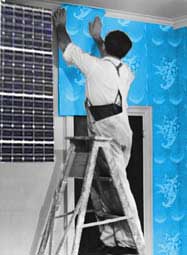Wall-to-wall power

On a roll: solar panels could soon be as cheap and easy to print as wallpaper. <br>© Photodisc / NSU <br>
Solar cells printed like wallpaper.
Solar cells might one day be produced by the roll, as cheaply and easily as wallpaper. Scientists in Arizona are using screen-printing, a technique developed for patterning fabrics, to produce plastic solar cells1.
The technique is another step towards the general availability of solar power from flexible devices on plastic sheets or glass panels. The basic materials of a photovoltaic cell are inexpensive, but combining them into a working device is currently costly. This limits our exploitation of the sun’s potential to provide clean energy.
The organic cells manufactured by Ghassan Jabbour and colleagues at the University of Arizona in Tucson have about a quarter of the efficiency of commercial silicon devices (which turn 10-20 per cent of light energy into electricity). But, being cheap to produce, they can make up in quantity what they lack in quality.
In conventional screen-printing, a taut piece of fabric, patterned by masking some areas with substances such as wax that repel colouring agents, is covered with ink or dye. The screen is then held horizontally over the object to be printed, and a rubber blade is swept across the back, pressing the coloured surface down to produce an image.
Jabbour’s group print very flat, very thin cells onto glass in a similar way. First, they coat the glass with a transparent, electrically conducting material that acts as one of the solar cell’s electrodes. On top of this, they lay down a thin film of a polymer, which helps to gather current from the photovoltaic material.
Finally, they deposit a blend of two organic compounds that convert light into electricity. One, a carbon-based molecule called a fullerene, produces charged particles that carry an electrical current when light shines onto the molecules. The other, a polymer, ferries the current to electrodes on the top and bottom of the cell.
Under blue light, these screen-printed solar cells have an efficiency of 4.3 per cent. They are probably less efficient for white sunlight, so there is work to be done before the devices are good enough for commercial use.
Organic solar cells were first reported last year by Bell Labs in the United States2. hese latest screen-printed cells are based on prototypes made by team member Sean Shaheen and colleagues earlier this year3.
References
- Shaheen, S. E., Radspinner, R., Peyghambarian, N. & Jabbour, G. E. Fabrication of bulk heterojunction plastic solar cells by screen printing. Applied Physics Letters, 79, 2996 – 2998, (2001).
- Schon, J. H., Kloc, C.H. & Batlogg, B. Efficient photovoltaic energy conversion in pentacene-based heterojunctions. Applied Physics Letters, 77, 2473 – 2475, (2000).
- Shaheen, S. E. et al. 2.5% efficient organic plastic solar cells. Applied Physics Letters, 78, 841 – 843, (2001).
Media Contact
All latest news from the category: Power and Electrical Engineering
This topic covers issues related to energy generation, conversion, transportation and consumption and how the industry is addressing the challenge of energy efficiency in general.
innovations-report provides in-depth and informative reports and articles on subjects ranging from wind energy, fuel cell technology, solar energy, geothermal energy, petroleum, gas, nuclear engineering, alternative energy and energy efficiency to fusion, hydrogen and superconductor technologies.
Newest articles

A new puzzle piece for string theory research
Dr. Ksenia Fedosova from the Cluster of Excellence Mathematics Münster, along with an international research team, has proven a conjecture in string theory that physicists had proposed regarding certain equations….

Climate change can cause stress in herring larvae
The occurrence of multiple stressors undermines the acclimatisation strategies of juvenile herring: If larvae are exposed to several stress factors at the same time, their ability to respond to these…

Making high-yielding rice affordable and sustainable
Plant biologists show how two genes work together to trigger embryo formation in rice. Rice is a staple food crop for more than half the world’s population, but most farmers…



